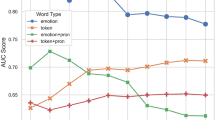Abstract
Members of online support communities help each other by empathising about common problems and exchanging information about symptoms and treatments. Results from two studies indicate that: empathy occurs in most online textual communities; empathetic communication is influenced by the topic being discussed; the presence of women tends to encourage empathy; and the presence of moderators not only reduces hostility but also appears to encourage empathy. The paper explores how empathy may be affected by pace of interaction, mode of expression and the way people reveal themselves in synchronous and asynchronous communities. As we advance towards technically better computer virtual environments, it is timely to pay greater attention to social issues such as empathetic communication.
Similar content being viewed by others
References
Ickes WE. Empathetic accuracy. Guildford Press, New York, 1997
King SA. Analysis of electronic support groups for recovering addicts. Interpersonal Computing and Technology: an Electronic Journal for the 21st Century, 1994; 2(3):47–56
Preece J. Empathetic communities: balancing emotional and factual communication. Interacting with Computers: the Interdisciplinary Journal of Human-Computer Interaction 1999; in press
Turkle S. Life on the screen: identity in the age of the Internet. Simon and Schuster, New York, 1995
Picard RW. Affective computing. MIT Press, Cambridge, Mass., 1997
Klien JT. Computer response to user frustration. Masters Thesis, MIT Program in Arts and Sciences of the MIT School of Architecture and Planning, 1999
Levenson RW, Ruef AM. Empathy: a psychological substrate. Journal of Personality and Social Psychology 1992; 63(2):234–246
Comfort A. Reality and empathy: physics mind and science in the 21st century. State University of New York Press, Albany, N.Y., 1984
Etchegoyen RH. The fundamentals of psychoanalytic technique. Karnac Books, London, 1991
Hodges SD, Wegner DM. Automatic and controlled empathy. In: Empathetic accuracy. Ickes W ed. Guildford Press, New York, 1997; 311–339
Rheingold H. The virtual community. Addison-Welsey, Reading, Mass., 1993
Sproull L, Kiesler S. Connections: new ways of working in the networked organization. MIT Press, Cambridge, Mass., 1991
Ackerman MS, Palen L. The Zephyr help instance: promoting ongoing activity in a CSCW system. In: Proceedings of CHI'96. ACM, New York, 1996; 268–275
Hiltz R. The virtual classroom: learning without limits via computer networks. Ablex Publishing, Norwood, N.J., 1993
Earls J. Social integration by people with physical disabilities: The development of an information technology model based on personal growth and achievement. PhD thesis. The University of Wollongong, Wollongong, Australia, 1990
Schoch NA, White MD. A study of the communication patterns of participants in consumer health electronic discussion groups. In: Proceedings of the 60th ASIS Annual Meeting. Information Today 1997; 34: 280–292
Pitkow J, Kehoe C. Emerging trends in the WWW population. Communications of the ACM 1996; 39(6): 106–110
Worth ER, Patrick TB. Do electronic mail discussion lists act as virtual colleagues. AMIA 1997; 325–329
Robson C. Real world research. Blackwell, Oxford, 1993
Hall JA. Gender effects in decoding nonverbal cues. Psychological Bulletin 1978; 85:845–857
Tannen D. Talking from 9 to 5. Morrow, New York, 1994
Preece J, Ghozati K. In search of empathy online: a review of 100 online communities. In: Proceedings of the 1998 Association for Information Systems Americas Conference. 1998; 92–94
Eisenberg N, Fabes RA, Schaller M, Miller PA, Sympathy and personal distress: development, gender differences and interrelations of indexes. In: Empathy and related emotional responses. Eisenberg N ed. Jossey-Bass, San Francisco, 1989
Lanzetta JT, Englis BG. Expectations of cooperation and competition and their effects on observer's vicarious emotional responses. Journal of Personality and Social Psychology 1989; 56:543–544
Tetzlaff L. Consumer informatics in chronic illness, Journal of the American Medical Informatics Association 1997; 4:285–299
Turner CF, Lessler JT, Devore JW. Effects of mode of administration and wording on reporting of drug use. In: Survey measurement of drug use: methodological studies. Turner CF, Lessler JT, Gfroerer JC eds. National Institute on Drug Abuse, Rockville, Md., 1992:177–220
Herring S. Gender and participation in computer-mediated linguistic discourse. ERIC Clearing House on Languages and Linguistics, 1992 (October)
Reid EM. Electronic chat: social issues on Internet relay chat. Media Information Australia 1993; 67: 62–70
Reid EM. Communication and community on Internet relay chat: constructing communities. In: High noon on the electronic frontier: conceptual issues in cyberspace. Ludlow P ed. MIT Press, Cambridge, Mass., 1996:397–411
Ramsay J, Barabesi A, Preece J. Informal communication is about sharing objects and media. Interacting with Computers: the Interdisciplinary Journal of Human-Computer Interaction 1996; 8(3): 277–283
Goleman D. Emotional intelligence. Bantam, New York, 1995
Sellen AJ. Remote conversations: the effects of mediating talk with technology, Human-Computer Interaction 1994; 10(4):401–444
Whittaker S. Rethinking video as a technology for interpersonal communications: theory and design implications. International Journal of Human-Computer Studies 1995; 42:501–529
Isaacs E, Tang J. What video can and cannot do for collaboration: a case study. Multimedia Systems 1994; 2:63–73
Hindmarsh J, Fraser M, Heath C, Benford S, Greenhalgh C. Fragmented interaction: establishing mutual orientation in virtual environments. In: Proceedings of ACM 1998 Conference on Computer Supported Cooperative Work, 1998: 217–226
Curtis P. Mudding: social phenomena in text-based virtual realities. In: Culture of the Internet. Kiesler S ed. Lawrence Erlbaum Associates, Mahwah, N.J., 1997; 121–142
Gaines BR, Chen LL, Shaw ML. Modeling the human factors of scholarly communities supported through the Internet and World Wide Web. Journal of the American Society for Information Science 1997; 48(11):965–1003
Author information
Authors and Affiliations
Corresponding author
Rights and permissions
About this article
Cite this article
Preece, J. Empathy online. Virtual Reality 4, 74–84 (1999). https://doi.org/10.1007/BF01434996
Issue Date:
DOI: https://doi.org/10.1007/BF01434996




